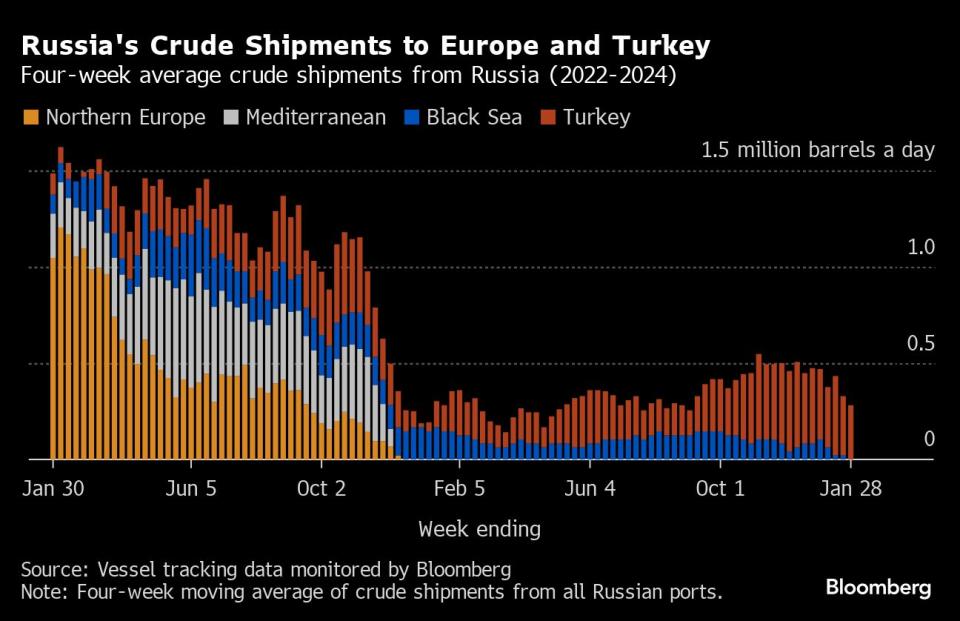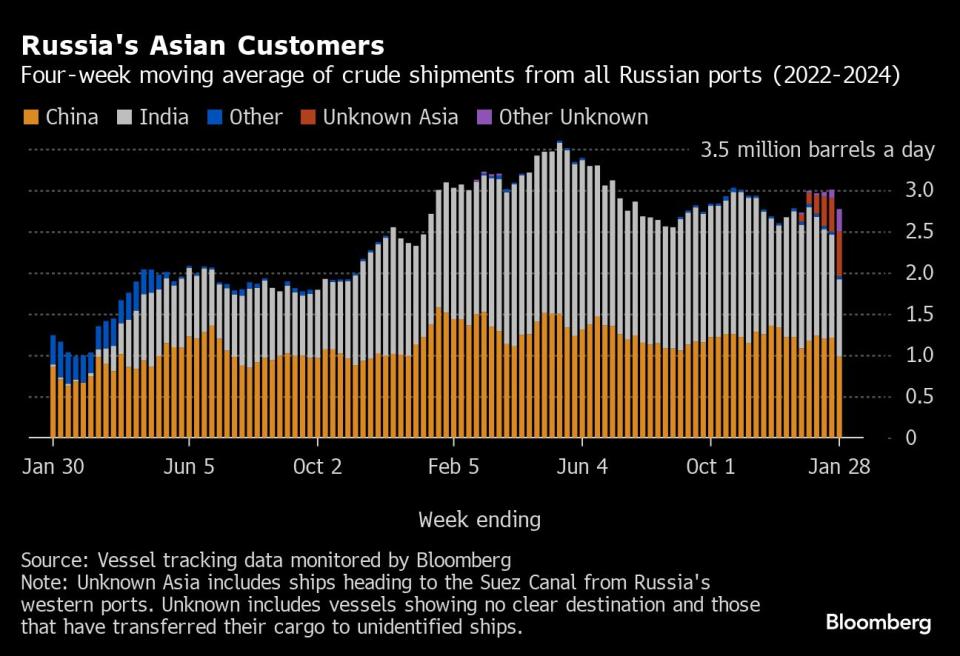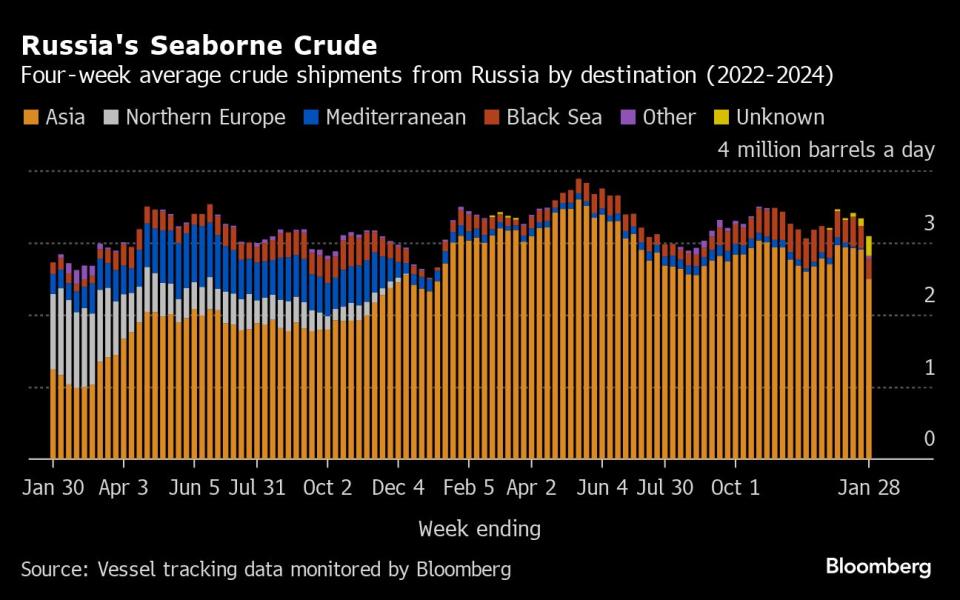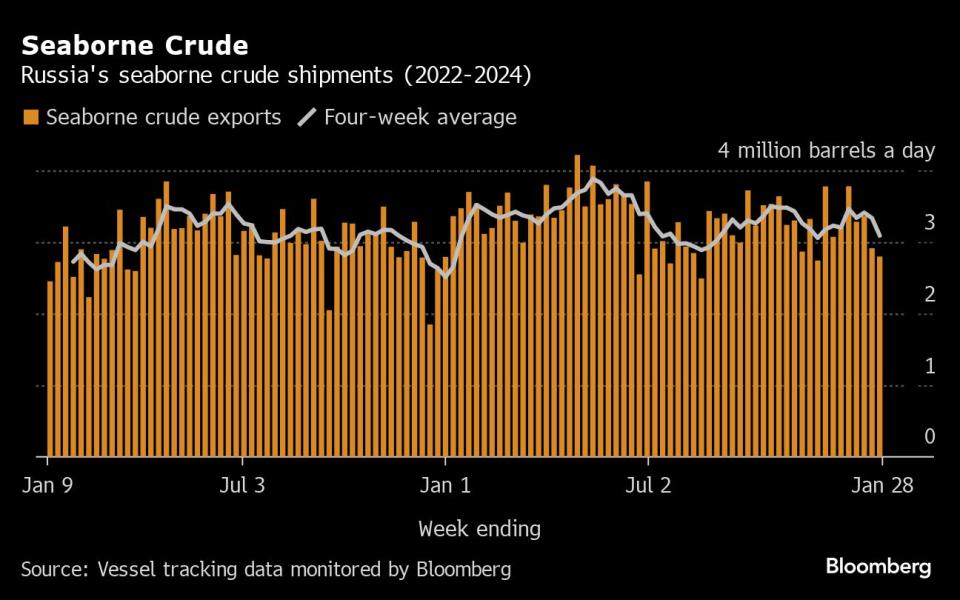Russia’s Seaborne Crude Exports Are Battered by Winter Storms
(Bloomberg) -- Russia’s seaborne crude shipments fell further last week, with flows from a key Pacific port that supplies Chinese buyers halted for five days by high winds and freezing temperatures.
Most Read from Bloomberg
Musk’s $55 Billion Pay Package Voided, Threatening World’s Biggest Fortune
Microsoft Sales Top Estimates; Cloud Growth Disappoints Some
Tech Giants Slide in Late Trading After Earnings: Markets Wrap
UPS CEO Kicks Off Productivity Drive by Cutting 12,000 Managers
About 3.09 million barrels a day of crude were shipped from Russian ports in the four weeks to Jan. 28, tanker-tracking data monitored by Bloomberg show. That was down by about 250,000 barrels a day from the revised figure for the period to Jan. 21.
The more volatile weekly average fell by about 120,000 barrels a day to an eight-week low of 2.8 million. Exports were hit by the storm that closed Kozmino and by four days of maintenance at the Baltic port of Ust-Luga, where loadings had been interrupted earlier by a Ukrainian drone strike on a nearby processing plant.
The impact of last week’s weather and maintenance disruptions was partly offset by a record-equaling 11 tankers loaded at Primorsk.
Russian crude destined for Asian buyers from western ports continues to pass through the Red Sea, despite attacks on merchant vessels from Yemen-based Houthi rebels.
Russia has said it will cut oil exports by 500,000 barrels a day below the May-June average during the first quarter, after several other members of the OPEC+ group agreed to make further output curbs. The Russian cut will be shared between crude shipments, which will be reduced by 300,000 barrels a day, and refined products. The four-week average crude measure was about 500,000 barrels a day below the May-June level.
In the Middle East, the Houthi militants have assured Russia and China that the group is “ready to ensure the safe passage of their ships in the Red Sea.” However, the first tanker reported to have been struck off Yemen was carrying Russian crude. The Sai Baba, carrying a cargo of Russian Urals crude, was hit by a drone off Yemen on Dec. 23, according to a post by the US Central Command on X, formerly known as Twitter. The Marlin Luanda, struck by a missile fired by the Houthis and set on fire on Friday, was carrying Russian naphtha.
Russia is still struggling to sell its Sokol crude. Twenty cargoes, totaling about 14 million barrels, are sitting on tankers that appear to be going nowhere. Another two 700,000 barrel cargoes are on their way to join them.
For the first time since Russia's invasion of Ukraine, shipments to Europe have hit zero on a four-week average basis, with Bulgaria — Moscow’s last customer in the region — taking nothing in the four weeks to Jan. 28.
The gross value of Russia’s crude exports fell to a five-month low of $1.32 billion in the seven days to Jan. 28 from a revised $1.33 billion the previous week. Meanwhile, four-week average income also slipped, down by $102 million to a six-month low of $1.41 billion a week.
Flows by Destination
Russia’s seaborne crude flows in the four weeks to Jan. 28 fell to 3.09 million barrels a day. That was down from a revised 3.34 million barrels a day in the period to Jan. 21, to the lowest in almost two months. Shipments were about 500,000 barrels a day below the average seen in May and June, or about 200,000 barrels a day below Russia’s first quarter target.
All figures exclude cargoes identified as Kazakhstan’s KEBCO grade. Those are shipments made by KazTransoil JSC that transit Russia for export through Novorossiysk and the Baltic port of Ust-Luga and are not subject to European Union sanctions or a price cap.
The Kazakh barrels are blended with crude of Russian origin to create a uniform export grade. Since Russia’s invasion of Ukraine, Kazakhstan has rebranded its cargoes to distinguish them from those shipped by Russian companies.
Asia
Most Read from Bloomberg
Observed shipments to Russia’s Asian customers, including those showing no final destination, fell to a five-week low in the 28 days to Jan. 28. Flows dropped to 2.77 million barrels a day from a revised 3 million in the period to Jan. 21.
About 980,000 barrels a day of crude was loaded onto tankers heading to China in the four weeks to Jan. 28. China’s seaborne imports are boosted by about 800,000 barrels a day of crude delivered directly from Russia by pipeline, either directly, or via Kazakhstan.
Flows on ships signaling destinations in India averaged about 940,000 barrels a day in the four weeks to Jan. 28.
Both the Chinese and Indian figures will rise as the discharge ports become clear for vessels that are not currently showing final destinations.
The equivalent of about 540,000 barrels a day was on vessels signaling Port Said or Suez in Egypt, or are expected to be transferred from one ship to another off the South Korean port of Yeosu. Those voyages typically end at ports in India or China and show up in the chart below as “Unknown Asia” until a final destination becomes apparent. This figure includes more than 15 million barrels of Sokol crude destined for India that has been stuck on ships since late November.
The “Other Unknown” volumes, running at about 270,000 barrels a day in the four weeks to Jan. 28, are those on tankers showing no clear destination. Most of those cargoes originate from Russia’s western ports and go on to transit the Suez Canal, but some could end up in Turkey. Others could be moved from one vessel to another, with most such transfers now taking place in the Mediterranean, off the coast of Greece.
Europe and Turkey
Russia’s seaborne crude exports to European countries have collapsed since Moscow’s troops invaded Ukraine in February 2022. A market that consumed about 1.5 million barrels a day of short-haul seaborne crude, coming from export terminals in the Baltic, Black Sea and Arctic has been lost almost completely, to be replaced by long-haul destinations in Asia that are much more costly and time-consuming to serve.
Combined flows to Turkey and Bulgaria, Russia’s only two remaining buyers close to its western ports, fell to about 280,000 barrels a day in the four weeks to Jan. 28, tanker-tracking data show. That’s down from about 310,000 barrels a day in the period to Jan. 21 and the lowest since September.
Exports to Turkey fell to a 16-week low of about 280,000 barrels a day in the four weeks to Jan. 28.
Flows to Bulgaria fell to zero in the most recent four-week period. Bulgaria’s parliament approved a measure to end imports of Russian oil from March, nine months earlier than permitted under an exemption to EU sanctions on purchases of Moscow’s oil.
No Russian crude was shipped to northern European countries, or those in the Mediterranean in the four weeks to Jan. 28.
Vessel-tracking data are cross-checked against port agent reports as well as flows and ship movements reported by other information providers including Kpler and Vortexa Ltd.
Export Value
Following the abolition of export duty on Russian crude, we have begun to track the gross value of seaborne crude exports, using Argus Media price data and our own tanker tracking.
The gross value of Russia’s crude exports fell to a five-month low of $1.32 billion in the seven days to Jan. 28 from a revised $1.33 billion the previous week. Meanwhile four-week average income also slipped, down by $102 million to a six-month low of $1.41 billion a week. The four-week average peaked at $2.17 billion a week in the period to June 19, 2022. The highest it reached last year was $2 billion a week in the period to Oct. 22.
During the first four weeks after the Group of Seven nations’ price cap on Russian crude exports came into effect in early December 2022, the value of seaborne flows fell to a low of $930 million a week, but soon recovered.
The chart above shows a gross value of Russia’s seaborne oil exports on a weekly and four-week average basis. The value is calculated by multiplying the average weekly crude price from Argus Media Group by the weekly export flow from each port. For shipments from the Baltic and Arctic ports we use the Urals FOB Primorsk dated, London close, midpoint price. For shipments from the Black Sea we use the Urals Med Aframax FOB Novorossiysk dated, London close, midpoint price. For Pacific shipments we use the ESPO blend FOB Kozmino prompt, Singapore close, midpoint price.
Export duty was abolished at the end of 2023 as part of Russia’s long-running tax reform plans.
Ships Leaving Russian Ports
The following table shows the number of ships leaving each export terminal.
A total of 26 tankers loaded 19.6 million barrels of Russian crude in the week to Jan. 28, vessel-tracking data and port agent reports show. That was down by about 830,000 barrels from the revised figure for the previous week.
A storm in the Pacific halved exports of ESPO crude from Kozmino. Tankers anchored in Nakhodka Bay waiting to load left the area in the early hours of Monday Jan. 22 and didn’t return until Friday.
Maintenance work cut exports from the Baltic port of Ust-Luga in the week to Jan. 28, with a four-day gap in loadings. A drone attack on a neighboring condensate processing plant briefly interrupted loading at Ust-Luga the previous week, but both crude berths at the terminal were in use again by Monday evening.
The losses at these two ports were partly offset by a record-equaling 11 tankers loaded at Primorsk during the week.
All figures exclude cargoes identified as Kazakhstan’s KEBCO grade. Three cargoes of KEBCO were loaded at Ust-Luga during the week.
NOTES
Note: This story forms part of a weekly series tracking shipments of crude from Russian export terminals and the gross value of those flows. Weeks run from Monday to Sunday. The next update will be on Tuesday, Feb. 6.
Note: All figures exclude cargoes owned by Kazakhstan’s KazTransOil JSC, which transit Russia and are shipped from Novorossiysk and Ust-Luga as KEBCO grade crude.
If you are reading this story on the Bloomberg terminal, click here for a link to a PDF file of four-week average flows from Russia to key destinations.
--With assistance from Sherry Su.
Most Read from Bloomberg Businessweek
There’s So Much Data Even Spies Are Struggling to Find Secrets
Basketball, Basketball, Basketball: Inside Steve Ballmer’s New $2 Billion Arena
Chinese Students Abroad Struggle With Tuition as Economy Falters
©2024 Bloomberg L.P.








